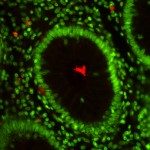Link to Pubmed [PMID] – 7500946
Mol. Gen. Genet. 1995 Nov;249(2):237-45
An in frame gene fusion containing the coding region for mature beta-lactamase and the 3′-end of hylA encoding the haemolysin secretion signal, was constructed under the control of a lac promoter. The resulting 53 kDa hybrid protein was specifically secreted to the external medium in the presence of the haemolysin translocator proteins, HlyB and HlyD. The specific activity of the beta-lactamase portion of the secreted protein (measured by the hydrolysis of penicillin G), approximately 1 U/microgram protein, was close to that of authentic, purified TEM-beta-lactamase. This is an important example of a hybrid protein that is enzymatically active, and secreted via the haemolysin pathway. Previous studies have indicated that haemolysin is secreted directly into the medium, bypassing the periplasm, to which beta-lactamase is normally targeted. This study indicated, therefore, that normal folding of an active beta-lactamase, can occur, at least when fused to the HlyA C-terminus, without the necessity of entering the periplasm. Despite the secretion of approximately 5 micrograms/ml levels of the active beta-lactamase fusion into the medium, there was maximally only a 50% detectable increase in the LD50 for resistance to ampicillin at the individual cell level. This result suggests that, normally, resistance to ampicillin requires a high concentration of the enzyme close to killing targets, i.e. in the periplasm, in order to achieve significant levels of protection.

